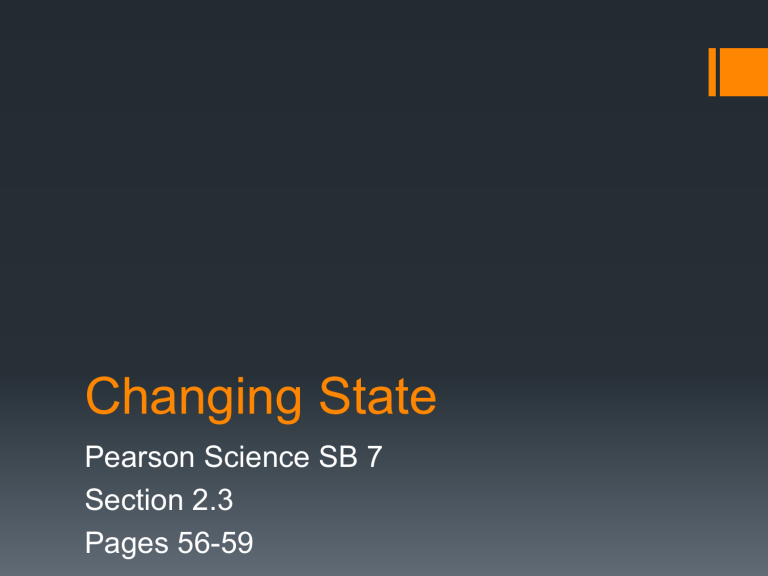
Changing State Pearson Science SB 7 Section 2.3 Pages 56-59 Adding Heat Given enough heat, solids will change into liquids and liquids will change into gas. Processes that involve addition of heat: Melting Evaporation Boiling Sublimation Melting Melting is the process in which adding heat causes a solid to change into a liquid. The substance remains the same substance- physical properties change Heat adds energy to particles causing them to vibrate faster Particles around edges are first to vibrate enough to break free Melting Point The temperature at which a solid melts A substance is solid below its melting point and liquid above the melting point Water’s melting point = 0˚ C Different substances have different melting points Melting Ice Animation Evaporation The process in which heat causes a liquid to change into a gas. Also known as vaporization. Adding enough heat/energy allows particles near the surface to move fast enough to break away and escape as gas. Evaporation Animation Boiling A special case of evaporation. Evaporation occurs at any temperature, but boiling only happens at the boiling point. Bubbles form and rise to surface to escape as gas. The boiling point is the temperature at which a liquid changes to a gas. It represents the highest temperature at which a substance is liquid and the lowest temperature at which it is gas. Water: BP = 100˚ C Boiling Animation Sublimation The process in which heat causes a solid to change directly into a gas. Examples: Iodine and solid carbon dioxide (dry ice) http://www.media.pearson.com.au/schools/ cw/au_sch_lewis_cw1/int/sublimation/f11/1 108.html Removing Heat A substance can change state if enough heat is removed from it. Processes involving removal of heat: Freezing Condensation Deposition Freezing Also known as solidification. Occurs when heat is lost and a liquid changes into a solid. As it cools, liquid loses energy from its particles so they slow down, vibrate on the spot, and form bonds between particles Water Freezing- Ice Bomb http://www.middleschoolchemistry.com/mult imedia/chapter2/lesson4#ice_bomb Freezing Point The temperature at which a liquid changes to a solid. Freezing is opposite process of melting, so occurs at same temperature. Water: FP = 0˚ C Condensation When a substance loses heat and changes from gas into liquid. As gas cools, particles slow down until they form bonds and liquid droplets Deposition Some gases change directly into solids without going through liquid state. States of Matter Video and Song http://teacher.scholastic.com/activities/stud yjams/matter_states/ Role Play P. 59




